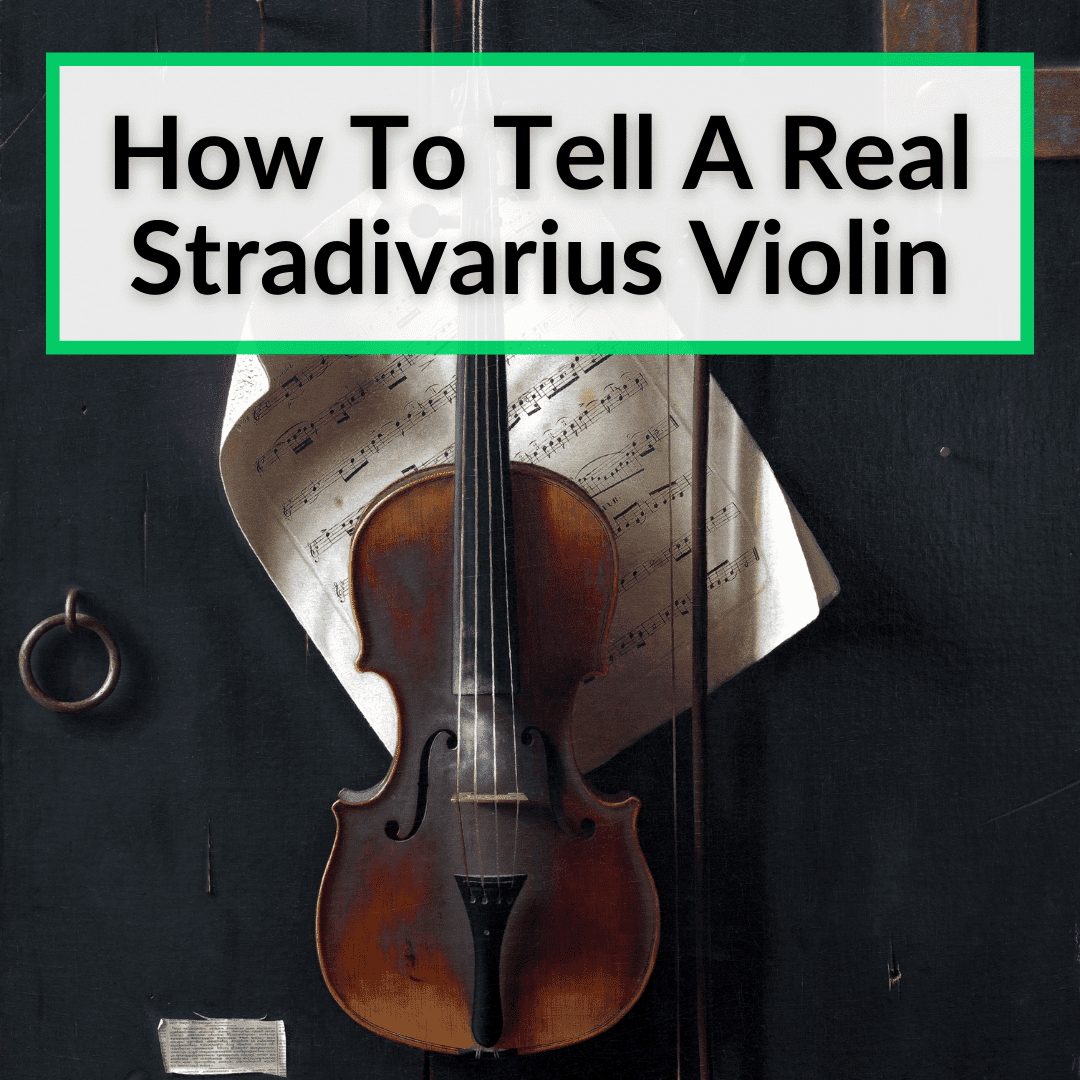 Everyone has head of Stradivarius violins.
Everyone has head of Stradivarius violins.
Even people who can’t play the instrument, and have nothing to do with it, know the name Stradivari.
Why is that?
Because he has a reputation for having made the best violins ever and his instruments are famous for having insanely high price tags.
It comes as no surprise that most of the famous violin players today use Stradivarius instruments.
It also comes as no surprise that there are tons of knock-offs out there.
If you think (or should I say hope) that you may have a real Stradivarius violin, you obviously need to know how to determine that for sure.
Keep reading to learn how to tell a real real Stradivarius violin from other models. Here’s hoping yours turns out to be authentic!
Table of Contents
How To Tell A Real Stradivarius Violin
Although it may seem impossible with the quality of modern violins, there are actually various ways to determine if your violin is really a Stradivarius.
They are quite unique, so can notice the difference in sound, responsiveness, and construction when compared to any other violin.
Antonio Stradivari, born in 1644, was a famous Italian instrument maker. His instruments – mainly cellos and violins – survived as a lasting testament to his ability to craft the most superior instruments that can still be played today.
Thousands of instrument makers over the years have copied Stradivari’s style in order to create their own instruments.
If you happen to have a violin that pretends to be a Stradivarius, chances are it’s not the real thing. Here is how you can tell.
Acoustics
Play the instrument to determine its sound quality. If you don’t know how to play, find a musician who can.
In an interview published on the National Public Radio (NPR) website, renowned violinist Miles Hoffman said of a true Stradivarius, “Beneath the ear, there’s a sweetness to it, there’s a depth of sound. It responds to the slightest touch.”
Stradivarius instruments are primarily known for their superior craftsmanship, as well as possessing a sound quality that often defies explanation.
Listen carefully as you or someone else plays the instrument. It should produce a powerful and pure sound.
Lower quality instruments will not project as well because they have more surface noise and less background noise. The sound produced by a true Stradivarius is rich, refined, and resonant, from the lowest notes to the highest.
Don’t worry if you are not an expert musician. In a direct side by side comparison of a great Stradivarius with a commercially produced instrument, or even with a handcrafted violin that was simply very good, the differences would be starkly clear, even to the most inexperienced listener.
Performance
Play the instrument, this time paying more attention to its responsiveness to your movements. A real Stradivarius will respond to the slightest touch — small changes in contact pressure.
Determine if your instrument has these qualities. Other instrument makers who label their own instruments as “Stradivarius” (the Latinized version of the Italian name) were not necessarily trying to pawn off their instruments as originals.
Rather, they were reflecting the original style from which their instruments were built. If you find that the instrument is not relatively easy to play, or not responsive, chances are you have such a duplicate on your hands.
Wood Composition
Have the instrument tested using infrared spectroscopy and nuclear magnetic resonance to analyze the chemical properties of the instrument panel. This analysis will determine your wood composition.
If the instrument sounds like a Stradivarius, have its physical characteristics tested to determine if it could have actually been produced in the Cremona area of Italy, where Stradivari lived and worked.
Compare the results to researchers from different universities in the United States: their study chemically analyzed shavings salvaged from two instruments and discovered the presence of a chemical wood preservative.
Analysis showed that violin wood has a different chemical composition than maple wood grown in the region today. The Italian masters used wood prepared by artificial means, treating the backs of their violins with copper, iron, and chrome.
Varnish
Have a sample taken and tested to determine the type of varnish on the instrument. Consider the results of the analyses.
Contrary to what you might believe, Stradivarius instruments do not feature a complex varnish. Instead, according to a study published in a German chemistry journal, Stradivari appears to have used a basic recipe of oil and resin to coat the wood.
Compare the results of these researchers’ findings. If the analysis detects the presence of chemicals other than the basic oil and resin recipe, then you do not own a Stradivarius.
Why Are Stradivarius Violins So Unique?
The mystery of the violin of the famous Italian master Antonio Stradivari has been present for the last 300 years.
During his long life, he produced about 1,100 string instruments: violins, violas, guitars, and cellos. About 550 violins, out of 960 estimated to have been made, still exist today.
Connoisseurs who have had the opportunity to see his works consider them amazing. His violin is very light – weighing less than half a kilogram.
Stradivari knew what he was doing. He used the perfect balance between hard and softwood so that the box could vibrate. He never made the same violin twice. He always tried to improve the sound and appearance.
Violinists are fascinated by Stradivarius violins. They consider it a “part of their body” and a “soul mate”.
The so-called Stradivari’s “Golden Age” lasted from 1700 to 1725 and has birthed arguably the best violins ever made.
One such violin, from 1716, is known as the “Messiah”. Currently, it is estimated to have a value of 20 million dollars, which may be the highest price of a Stradivarius violin.
Antonio Stradivari is believed to have been born in 1644, although the date is not recorded anywhere. It is possible that between 1666 and 1679 he was a student of Nicolo Amati, although there are facts that deny that.
In any case, in 1680, he became independent and opened his workshop on Piazza San Domenico in the city of Cremona (Italy). He soon became popular as a master of exceptional qualities.
He began to make models in the style of Amati, but also to change bows and experiment with different thicknesses of wood and varnishes. His instruments are recognizable by the Latin inscription “Antonius Stradivarius Cremonensis Faciebat Anno…” (Made by Antonio Stradivari of Cremona …).
According to today’s opinion, he made the best instruments between 1698 and 1725, with the best examples being made around 1715, and a decline in quality noticeable after 1725.
The instruments after 1730 were signed by Sotto la Desciplina d’Antonio Stradivari F. in Cremona and were probably made by his sons Omobono and Francesco.
Antonio Stradivari was buried on December 18, 1737, in the Basilica of San Domenico in Cremona. The church was demolished in 1868, and the remains of Antonio Stradivari could not be identified, so they were not moved to a new tomb.
Identifying A Real Stradivarius Violin: Final Thoughts
If you suspect you might have a true Stradivarius violin, run through the tests outlined above. If they end up indicating that yours is a real one, then it would be worth it to have an expert test it to make sure.
That may cost some money, but it is worth it if it verifies your violin as a real Stradivarius. Because that will mean you’re loaded!
And since you’re loaded, it should go without saying to not skimp on shipping, if you need to send your violin away to get it tested. Know how to ship a violin safely and spend money on the best possible courier service to ensure it arrives safely.




Antonio died in 1737 ,so sorry not made by Stradivarius
I have one 1733. I’m in New Zealand where can I get it authenticated please?
Why not?
I have a violin that was given to me when I was in grade school. I played in the school orchestra’s until high school.. I’m now 80 years old and still have it. The inside label says it’s an Antonia’s Stradivarius, 1913. The violin sounds good and has a nice finish. It’s probably not a true Strat, but it’s a pretty violin. Loved all the information on the fakes and the real, true ones. I think it has helped me out .It also has another label that says, Albin Luvig Paulus Jr. Just curious……Why so many labels?